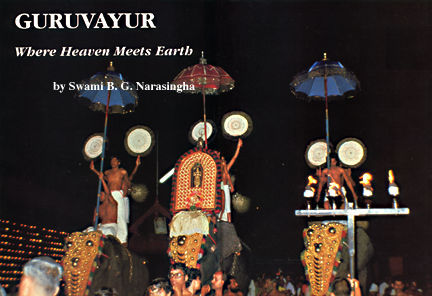
Many attributes contribute to the popularity of India's prominent temples. Konark, the Sun temple in the state of Orissa, is famous for its unique architecture. Sri Rangam, situated on the Kaveri River in Tamil Nadu, is known for its antiquity. Badrinath, high in the Himalayas, is popular on account of its unique geographical location, and Jagannath Puri, on the Bay of Bengal, is noted for its legendary festival of the chariots, held annually for over 2000 years. All these factors combine at Guruvayur, in the South Indian state of Kerala, making Guruvayur one of the most enchanting and glorious temples in all of India.
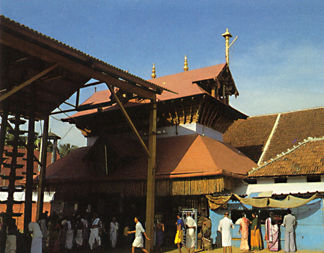 There are no movie theaters in the town of Guruvayur. No liquor stores. No night clubs. And no meat is eaten there. Guruvayur is a holy city where people come to make spiritual advancement. In fact, the atmosphere of devotion which pervades Guruvayur is so sublime and charming that one easily experiences transcendence when visiting this holy place. Appropriately so, Guruvayur is known as Bhuloka Vaikuntha: "where heaven meets Earth."
There are no movie theaters in the town of Guruvayur. No liquor stores. No night clubs. And no meat is eaten there. Guruvayur is a holy city where people come to make spiritual advancement. In fact, the atmosphere of devotion which pervades Guruvayur is so sublime and charming that one easily experiences transcendence when visiting this holy place. Appropriately so, Guruvayur is known as Bhuloka Vaikuntha: "where heaven meets Earth."
A visit to Guruvayur, though common to the people of India, is something very few Westerners have ever experienced. At the nucleus of the city lies a large wooden temple in the typical Kerala style-- striking, elegant, and peaceful. However, upon closer scrutiny one can perceive a mysterious energy emanating from the temple that daily draws thousands of pilgrims through its doors. It is astounding to observe the overwhelming number of pilgrims who come to the shrine each day as if attracted by some irresistable force--a force unseen by the eyes and undetectable by scientific instruments, yet so powerful that millions are captivated by it. What is that force? "It is the supreme mysticism," says a brahman priest of the temple. "It is the power of divine love, or more precisely--beauty, charm, and sweetness."
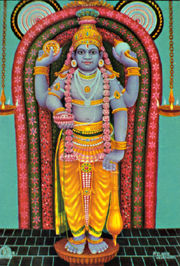 Entering an enclosed sanctuary where only orthodox Hindus are allowed, one comes face to face with a majestic deity of Vishnu hewn out of black stone, decorated with valuable jewels, and positioned on a fabulous gold and silver throne. "Can stone emanate love, beauty, charm, and sweetness?"--a difficult question for any rational thinker, but evidently it can, since that is the remarkable force that one encounters at Guruvayur.
Entering an enclosed sanctuary where only orthodox Hindus are allowed, one comes face to face with a majestic deity of Vishnu hewn out of black stone, decorated with valuable jewels, and positioned on a fabulous gold and silver throne. "Can stone emanate love, beauty, charm, and sweetness?"--a difficult question for any rational thinker, but evidently it can, since that is the remarkable force that one encounters at Guruvayur.
According to the age-old traditions of India, Vishnu is considered to be the original person; whatever exists emanates from him. From the smallest atoms in the universe up to the unlimited planets and stars floating in space--including all animate and inanimate entities-- everything is a manifestation of his energy. He is the origin of all beauty. 'The deity is not stone," says a temple brahman. "Stone is the media by which Vishnu reveals himself to the entities of this mundane world who have no vision of spiritual existence. Because he is the source of everything, he is all-attractive; his form is the abode of supreme beauty, his activities are most charming, and his existence is sweetness personified. As the all-attractive source, Vishnu is the supreme object of love and the supreme giver of love: indeed, he is divine love incarnate." Thus the pilgrims come to Guruvayur captivated by the all-attractive power of divine love.
The temple itself has existed for about 5,000 years, although it is said that the deity is much older. It is written in palm leaf scrolls which are kept in the sacred temple that the deity was first worshiped by the demigod Brahma at the beginning of the padma kalpa. In the varaha kalpa, Sutapa and Prishni, who had no children, prayed to Brahma for the gift of a son. Brahma gave them the deity of Vishnu to worship, and said that their desire for a child would soon be fulfilled. After worshiping the deity for some times, Vishnu offered them a benediction, and Sutapa and Prishni then requested Vishnu to personally become their son. Thus, in three separate avatars (incarnations), Vishnu as Prishnigarbha, Vamana, and Krishna, became their son.
In each of the incarnations the deity also reappeared and was worshiped by Sutapa and Prishni. During the Krishna avatar, the deity was worshiped in a temple in Dwaraka for 100 years. When the time came for Krishna's ascent into the spiritual world, Krishna instructed the guru of the demigods, Brihaspati, and Vayurdeva, the demigod of the wind, to take charge of the worship of the deity. When Brihaspati and Vayur arrived at Dwaraka, the city had already been inundated by the sea. Searching beneath the turbulent waves they were able to rescue the deity, and after raising it from the sea, they departed toward the south.
After travelling a long distance, Brihaspati and Vayur reached a secluded lake near the seashore. The two celestial entities sat down and began to meditate; subsequently, the demigod Shiva emerged from the depths of the lake. After some discussing it was decided by those three divine beings that the side of the lake known as Rudratirtha would be the best location for a new temple to be constructed; since then, the place became known as Guruvayur--guru meaning Brihaspati and vayurVayurdeva.
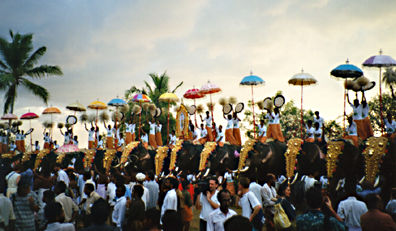
Fifty centuries have passed since the founding of the temple, as have its many trials and tribulations: Guruvayur has risen to glory and fallen to brink of extinction several times during that span of time. There were periods of royal patronage when Hindu kings used to pay homage to the temple by donating vast amounts of wealth. In those days the temple owned many smaller farming villages around Guruvayur: argicultural fields, vast herds of cows, and even 1,000 elephants. Then there were times when the armies of the Sultan of Delhi ravaged all of South India, burning, killing, and destroying the sacred shrines. But whatever the difficulties, Guruvayur has managed to survive and again rise to glory.
Since India's independence from British rule in 1947, Guruvayur has not enjoyed the patronage of Hindu royalty, yet the temple has prospered and is presently one of the most popular in the country. The temple opens its door at 3 A.M. to an already-anxiously awaiting crowd of several hundred pilgrims. The first event of the morning is called darshan, the waking of the deity. In the morning darshan the deity is bathed with scented waters, dressed in opulent clothing, and served a variety of delicious vegetarian foods. Throughout the day, there are other elaborate functions which include the offering of 1,000 coconuts and the lighting of oil lamps. Not a moment of the day slips away without there being some spectacular activity.
A seemingly alien aspect of deity worship which many occidentals have a difficult time adjusting to is the intensity with which the worshipers regard the deity as a person. We are continually reminded by the reoccuring rituals that the deity is not stone, but a person; bathing, dressing, offering of food, singing, dancing, and even theatrical performances are performed for the satisfaction of the deity. When we asked about deity worship being considered idol worship, the brahmans replied, "God has form and transcendental attributes. If those attributes are present in a form of stone or wood or metal, then that is not idol worship."
During the mid-morning hours, there are martial arts demonstrations, and many wedding ceremonies also take place in front of the temple, one after another. Believing that being married at Guruvayur is a great blessing, devoted couples come here from all over South India.
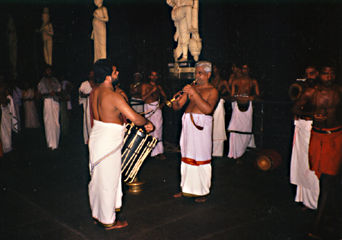 In the evening, varieties of classical dance such as bharat-natyam and kathakali are performed in an open courtyard. The actors combine music, dance, and drama to tell of the many mircales performed by the deity. One such story is that of Manjula, the sweeper's daughter. Sweepers and their families are considered untouchable by certain sections of Hindu society. However, this apparent social impasse did not discourage Manjula in her devotion to Vishnu. Fortnightly, Manjula would make a pilgrimage from her village to visit Guruvayur. It was her regular practice to make a flower garland from flowers grown in her garden to bring as an offering to the deity. One day, due to bad weather, Manula was delayed, and by the time she reached the temple, the doors were closed and bolted for the night. Manjula was very much attached to offering a garland before the deity, and so she sat down in front of the temple and began to cry.
In the evening, varieties of classical dance such as bharat-natyam and kathakali are performed in an open courtyard. The actors combine music, dance, and drama to tell of the many mircales performed by the deity. One such story is that of Manjula, the sweeper's daughter. Sweepers and their families are considered untouchable by certain sections of Hindu society. However, this apparent social impasse did not discourage Manjula in her devotion to Vishnu. Fortnightly, Manjula would make a pilgrimage from her village to visit Guruvayur. It was her regular practice to make a flower garland from flowers grown in her garden to bring as an offering to the deity. One day, due to bad weather, Manula was delayed, and by the time she reached the temple, the doors were closed and bolted for the night. Manjula was very much attached to offering a garland before the deity, and so she sat down in front of the temple and began to cry.
Suddenly a brahman appeared from the shadows and asked Manjula why she was crying. Manjula told the brahman of her having come such a long distance only to find the temple closed. Thus the brahman reassured her, "Vishnu never rejects the service of his sincere devotees. Make your offering here by hanging the garland on the temple door. Vishnu will certainly accept it." Manjula hung the garland on the door as advised by the brahman and then went away for the night.
At 3 A.M. many pilgrims gathered outside the temple gates waiting for the priests to come and open the temple. Manjula was also there waiting, but she did not see the garland that she had left the night before. When the doors were unlocked, upon entering the sanctuary everyone was surprised to see the deity wearing a fresh flower garland. Everyone began to wonder how this had happened: since the doors of the temple were locked from outside, it was not possible for anyone to have entered and placed the garland on the deity. Manjula almost fainted--the deity was wearing the garland that she had hung on the temple door the previous night. For one continuous month the deity wore the garland and it did not wilt, but remained fresh and fragrant.
The evening hours bring about the main event of the day: a deity procession led by jewel- and gold-bedecked elephants. In fact, the elephant processions held at Guruvayur are famous all over India. Before the procession begins, people gather outside the temple to watch the elephants who are guaranteed to put on a sensational show. Although a common sight in most parts of India, the elephant never loses his charisma. Everyone enjoys seeing the huge body of the elephant as he sways to and fro, swinging his trunk in perfect harmony with his powerful steps.
Before the procession, the three elephants chosen to be its feature attraction are first fed a quantity of sweets made from gour (resembling brown sugar and molasses) mixed with cooked rice and rolled into elephant-bite-sized portions the size of basketballs. Each of these hearty beasts consumes at least half a dozen of these delicacies before having reached his fill. Afterwards the elephants are attired in brightly-colored silk headdresses decorated with gold and other ornaments.
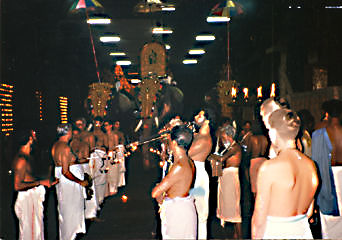 As the crowd begins to stir, a brahman steps forward and blows three blasts on a conchshell, thereby announcing the arrival of the deity. A priest emerges from the sanctuary bearing the mahotsava-murti (a gold miniature of the main deity) on his head and quickly climbs up on the back of the center elephant. Instantly, several other brahmans carrying festial umbrellas, peacock feather cans, banners, and festoons join him and mount the back of the othe two elephants. Drums, shenai (a wind instrument), gongs, and cymbals begin to play. The procession begins.
As the crowd begins to stir, a brahman steps forward and blows three blasts on a conchshell, thereby announcing the arrival of the deity. A priest emerges from the sanctuary bearing the mahotsava-murti (a gold miniature of the main deity) on his head and quickly climbs up on the back of the center elephant. Instantly, several other brahmans carrying festial umbrellas, peacock feather cans, banners, and festoons join him and mount the back of the othe two elephants. Drums, shenai (a wind instrument), gongs, and cymbals begin to play. The procession begins.
The procession moves clockwise around the temple complex three times, but before proceeding past the first turn, 10,000 oil lamps arranged along the outer wall of the sanctuary are lit to illumine the way. This is quickly done by the hundreds of pilgrims taking part in the procession.
Music plays, oil lamps flicker, and the elephants graciously circumambulate the temple three times. Stopping at intervals, the elephants raise their mighty trunks and let loose with a penetrating scream, heralding the glory of God. Everyone experiences transcendental happiness by taking part in this function which is a culmination of the whole day's activities. "If the deity is pleased," says a brahman, "then we are automatically in ecstasy." "No argument there," I said, since I myself was also swept away in the ocean of transcendental bliss.
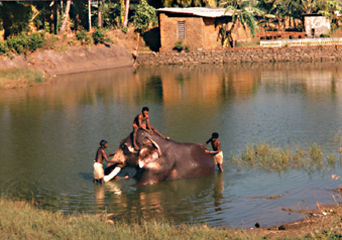 Because the elephant procession is held every night of the year--with additional processions held on special festival days--the Guruvayur temple owns an elephant ranch where 46 elephants are trained to perform ceremonial functions. In the history of the temple, several elephants stand out as special. One of the most famous was Keshava, also known as Gajarajan or "the king of elephants."
Because the elephant procession is held every night of the year--with additional processions held on special festival days--the Guruvayur temple owns an elephant ranch where 46 elephants are trained to perform ceremonial functions. In the history of the temple, several elephants stand out as special. One of the most famous was Keshava, also known as Gajarajan or "the king of elephants."
Keshava's unique devotion for his service at Guruvayur will not soon be forgotten. When Keshava became the leading elephant in the temple herd, he would not tolerate another elephant's carrying the deity. Once, when another elephant was selected to carry the deity in the procession, Keshava became so disturbed that he intimidated the other elephant and chased him away. Whenever Keshava was to carry the deity, he would demonstrate his eagerness to perform his service by pulling at the chains that bound his feet. Once, just before a procession was about to begin, Keshava broke away from his trainer and went on a rampage, running around the temple five times. There were thousands of men, women, and children present when this occured; however, Keshava was careful not to harm anyone as he ran. He even stopped momentarily when a small child wandered into his path. After completing his circumambulation, Keshava stood peacefully in front of the temple waiting for the event to begin, but his trainers were afraid to approach him.
On the days of ekadasi, the eleventh day of the waning and waxing moon, it is the custom at Guruvayur for all the brahmans and even pilgrims to observe a fast. Keshava would also voluntarily observe the fast on ekadasi. He would abstain from eating even if offered his favorite dish, fresh-cut banana stocks.
Keshava performed his duties at Guruvayur for more than 50 years. During one evening's festivities, Keshava became acutely ill just at the time of the deity procession. When his huge body began to tremble, he was removed from the area and taken to his stall, where he remained standing throughout the night. The next day he would not allow anyone, even the veterinarian, to approach him. That evening, when the conchshell blew to announce the beginning of the procession, Keshava forced his way out of his stall and returned to the front of the temple. Everyone was surprised to see Keshava suddenly standing there. Keshava had come to pay his last respects to a master that he clearly loved very deeply. Just as the deity appeared from the sanctuary, Keshava bent his mighty knees and bowed his head to the ground before the deity. In the instant that followed, surrounded by solemn onlookers, while music played and conchshells blew, the "king of elephants" departed from his mortal body and attained the realm of the infinite-- a most dramatic event.
When pilgrims arrive at Guruvayur, they are reminded of Keshava by his giant tusks and protrait displayed above the main entrance to the temple. Throughout the city and marketplaces, many shops sell colorful paintings of Keshava which pilgrims eagerly buy. Keshava is not remembered simply as an unusual elephant, but as a person---a spiritual being who had awakened his divine love for God.
The sagas of Manjula and Keshava are but two of the many legends of Guruvayur which beautifully illustrate how the power of divine love overcomes all obstacles. The power of love is indeed a mysterious thing: it extends beyond the need for logical explanation. It transcends all parriers of race and occupation--male and female, man and animal, time and space. The domain of divine love is independent of all mundane dispensations. It is the secret of all secrets and the splendid power behind Guruvayur.
